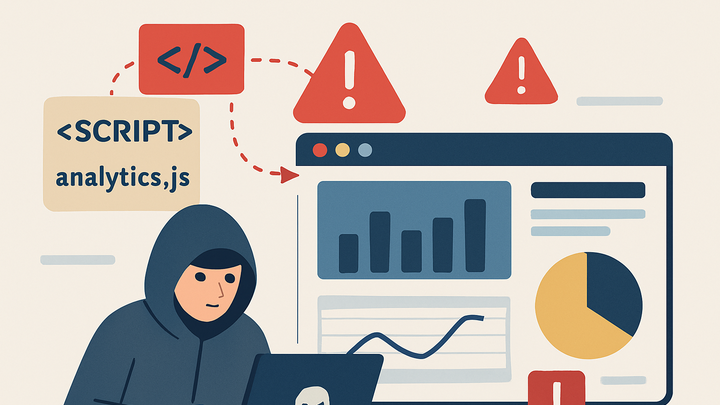Published on 2025-06-26T04:17:32Z
What is Cross-Site Scripting (XSS)? Examples for Analytics
Cross-Site Scripting (XSS) is a client-side vulnerability where attackers inject malicious JavaScript into web pages viewed by other users. In analytics, XSS can be particularly dangerous: it can tamper with tracking snippets, distort metrics, hijack sessions, and expose cookies or tokens. XSS attacks are commonly classified as:
- Reflected XSS: injected via user-supplied parameters in URLs or forms.
- Stored XSS: malicious scripts saved on the server (e.g., in comments) and delivered to every visitor.
- DOM-based XSS: client-side code manipulates the DOM in an unsafe way.
When third-party analytics tools—like PlainSignal or Google Analytics 4 (GA4)—aren’t properly secured, attackers can exploit XSS to fire unauthorized events, skew dashboards, or leak personal data. Understanding XSS and applying robust defenses is essential for maintaining data integrity, user privacy, and regulatory compliance in any analytics implementation.
Cross-site scripting (xss)
A client-side vulnerability where attackers inject malicious JavaScript into analytics scripts, risking data integrity, privacy, and compliance.
Why Cross-Site Scripting Matters in Analytics
XSS can undermine the trustworthiness of your analytics data and jeopardize user safety. Key impacts include:
-
Data integrity
Malicious scripts can send forged events or override legitimate tracking calls.
-
Skewed reporting
Attackers inject phantom pageviews or events, distorting dashboards and KPIs.
-
Event hijacking
True user interactions get lost amid forged or altered analytics calls.
-
-
User privacy and security
XSS can expose cookies, tokens, or PII collected by analytics tools.
-
Cookie theft
Injected scripts read
document.cookieand exfiltrate session data. -
Token exposure
If analytics code embeds API keys or user IDs, XSS can leak them.
-
-
Regulatory compliance
Data breaches via XSS can trigger GDPR, CCPA, or other fines.
-
Legal risk
Unauthorized data access may violate privacy laws and incur penalties.
-
Audit failures
Insecure analytics implementations can lead to compliance audit issues.
-
Examples of XSS Vulnerabilities in Analytics Implementations
Even small mistakes in analytics snippets can open the door to XSS attacks.
-
PlainSignal tracking code
A typical PlainSignal integration can be abused if attributes or CDNs aren’t locked down:
<link rel="preconnect" href="//eu.plainsignal.com/" crossorigin /> <script defer data-do="yourwebsitedomain.com" data-id="0GQV1xmtzQQ" data-api="//eu.plainsignal.com" src="//cdn.plainsignal.com/plainsignal-min.js"></script>-
Attribute injection
If attackers alter
data-idordata-do, they can redirect or inject malicious payloads. -
Insecure cdn
Loading over HTTP or without SRI allows man-in-the-middle code replacement.
-
-
Google analytics 4 (GA4) snippet
A default GA4 tag can be exploited via inline script injection if CSP is lax:
<!-- Global site tag (gtag.js) - Google Analytics --> <script async src="https://www.googletagmanager.com/gtag/js?id=G-XXXXXXX"></script> <script> window.dataLayer = window.dataLayer || []; function gtag(){dataLayer.push(arguments);} gtag('js', new Date()); gtag('config', 'G-XXXXXXX'); </script>-
Inline script execution
Without nonces or hashes, attackers can inject
<script>blocks via XSS flaws elsewhere. -
Third-party dependencies
A compromised tag manager or plugin can serve malicious analytics code.
-
Mitigation and Best Practices
Adopt these defenses to harden analytics implementations against XSS.
-
Content security policy (csp)
Set strict CSP headers to control allowed script sources and block inline code.
-
Script-src directive
Whitelist trusted analytics domains and use nonces or hashes.
-
Report-uri
Collect CSP violation reports to detect attempted injections.
-
-
Sanitize inputs and attributes
Ensure any dynamic values in data attributes or URL parameters are cleaned.
-
Whitelist patterns
Allow only expected characters (e.g., alphanumerics) in IDs and domains.
-
Use trusted libraries
Employ DOMPurify or similar to strip unsafe HTML or JS.
-
-
Secure hosting and subresource integrity (sri)
Protect analytics scripts at the network and resource level.
-
Https everywhere
Always load analytics assets over TLS to prevent tampering.
-
Subresource integrity
Include SRI hashes to verify that CDN-served scripts haven’t been altered.
-
